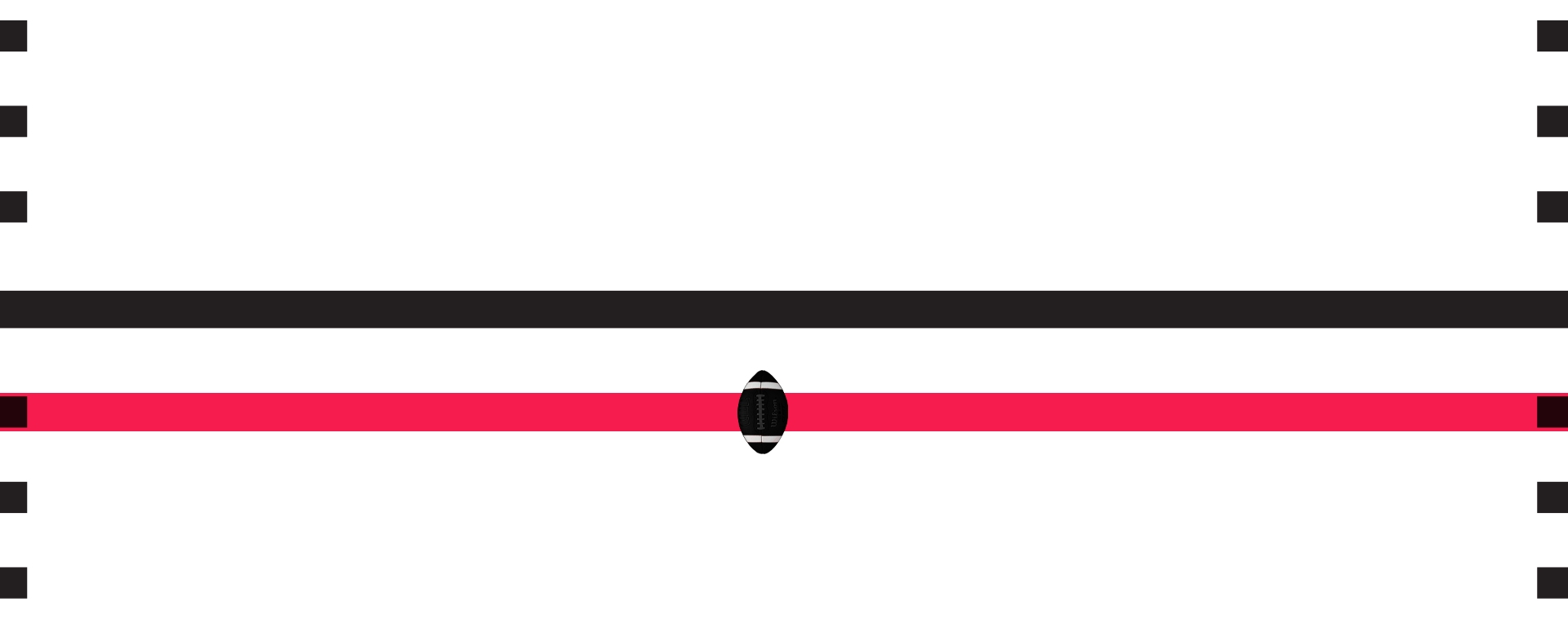Football Glossary
Learn to speak fluent football in no time.
Snap: A backward pass between the legs from the center to the quarterback.
Line of scrimmage: An imaginary line drawn from where the ball is placed at the end of a play. Neither team can cross the line until the ball is snapped.
The line of scrimmage in salmon.
Rush: When the quarterback, running back, or receiver runs beyond the line of scrimmage with the ball.
Catch: When the wide receiver or running back receives the pass from the quarterback. A catch can consist of one or two hands, a secure possession, and at least one foot inbounds on the field of play.
Line to gain: The line an offense needs to cross to gain a first down or touchdown.
Cross each line to gain to get a first down, or to score.
Down: The brief period of play that starts when the ball is snapped and ends when the whistle is blown. The offense gets 4 downs to reach the next line to gain. A flag pull behind the line of scrimmage can result in an addition of yards and a loss of down, forcing the offense to tack on the yards lost to the original line to gain to achieve another first down.
False Start: When an offensive player moves with the intention to start the play before the ball is snapped. A movement as subtle as a flinch can trigger a false start penalty.
Offside: When any part of a player’s body is beyond the line of scrimmage as the ball is being snapped. If the defense commits an offside penalty, that very snap is considered to be a free play granted to the offense. If that free play ends in a negative outcome for the offense, that outcome can be negated by the offside infraction.
Holding: When a player uses her hands to grab any part of an opponent’s body or uniform with intent to slow their progress. Both players on the offensive and defensive sides of the ball can commit this penalty.
Clipping: A push in the back (illegal), committed by an offensive or defensive player.
Endzone: The 10 yard ends of a football field. If a ball carrier or a pass catcher crosses into this area with possession of the ball, six points will be awarded to her team.
Lateral: A player in possession of the ball, pitching the ball to a teammate behind her. A drop of a lateral will result in the immediate end of the play (as there are no fumbles in flag football). A lateral can occur both beyond and behind the line of scrimmage.
Redzone: The 14 yards that lead up to the endzone. Offensive play typically becomes more difficult when initiated in this area.
The redzone area of the football field.
Pass Interference: When a defender makes contact with the targeted receiver that interrupts her ability to catch the pass. Offensive players can also commit pass interference against defenders to keep them making a play on the ball.
Interception: When the defense catches a ball thrown by the offense. Also commonly known “I-N-T”, or “pick”. When the defense makes an interception and returns it for a touchdown, that is called a “pick-six”.
Sack: A flag pull on the quarterback, behind the line of scrimmage.
Intentional Grounding: A penalty assessed to the offense If the QB is being rushed and intentionally throws the ball either into the ground, or not in the vicinity of another offensive player to avoid a sack.
Safety: There are three ways to get a safety; 1) A flag pull on a ball carrier in their own endzone. 2) When a ball carrier steps on, or runs through the backline of her own endzone. 3) A QB committing an intentional grounding infraction in her own endzone. The team that forces a safety earns two points, and will immediately receive the ball on offense on the 14 yard-line.
Roughing the Passer: Making contact just before, during, and immediately after the passer’s throwing motion. Attempting to knock down a pass attempt and making incidental contact with the forward movement of passer’s throwing arm also counts as roughing the passer.
Blitz: When the defense sends more defenders to sack the QB than the offense can block. Blitzing leaves defenders in coverage more vulnerable.
Turnover on Downs: When an offense goes for it on fourth down and fails to reach the line to gain. The opposing team then gets the ball where the play was blown dead.
Breaking the Plane: The beginning of the line to gain has an invisible wall that spans the length of the field and goes up indefinitely. That wall is called a “plane”. Only the ball needs to break the plane to achieve a first down or touchdown. Reaching the ball over the line to gain with one arm (or two) counts just the same as entering the plane with your whole body.
The ball breaking the plane (as pictured here) would count as a touchdown.





